
Carex jamesii, known as James's sedge or grass sedge, is a species of sedge native to North America from Minnesota east to New York and south to Oklahoma and South Carolina. It occurs in mesic hardwood forests and produces fruits from early May to mid July. It has two to four perigynia that are subtended by leaf-like pistillate scales. Its seeds are dispersed by ants.

In botany, a perigynium, also referred to as a utricle, typically refers to a sac that surrounds the achene of plants in the genus Carex (Cyperaceae). The perigynium is a modified prophyll, also known as a glume, which is tissue of leaf origin that encloses the dry, one-seeded achene.

Ribes americanum is a North American species of flowering plant in the gooseberry family known as wild black currant, American black currant, and eastern black currant. It is widespread in much of Canada and the northern United States.

Carex lacustris, known as lake sedge, is a tufted grass-like perennial of the sedge family (Cyperaceae), native to southern Canada and the northern United States. C. lacustris us an herbaceous surface-piercing plant that grows in water up to 50 cm (1.6 ft) deep, and grows 50–150 cm (1.6–4.9 ft) tall. It grows well in marshes and swampy woods of the boreal forest, along river and lake shores, in ditches, marshes, swamps, and other wetland habitat. It grows on muck, sedge peat, wet sand or silt, in filtered or full sunlight.
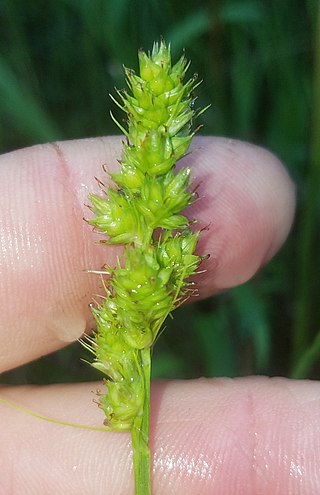
Carex austrina, known as southern sedge, is a species of sedge endemic to the southern and central United States.
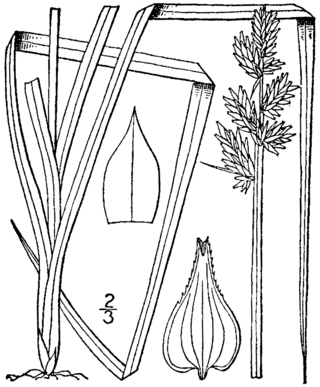
Carex conjuncta, known as soft fox sedge, is a species of sedge that was first formally named by Francis Boott in 1862. It is endemic to the central and eastern United States.
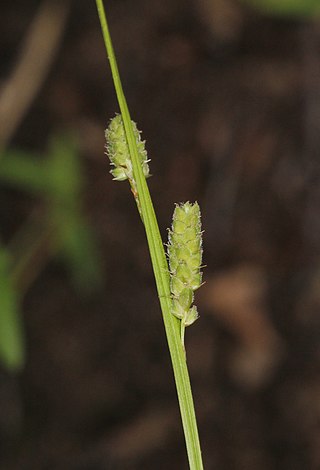
Carex swanii, known as Swan's sedge or downy green sedge, is a species of flowering plant in the family Cyperaceae. It is native to eastern North America.
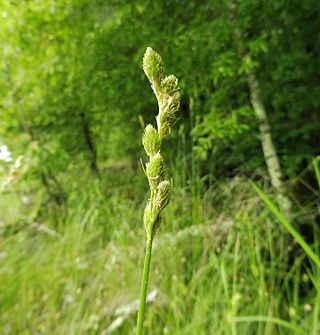
Carex alata, commonly called broad-winged sedge, is a species of flowering plant in the sedge family. It is native to eastern North America, in Canada and the United States. It grows in wet, marshy areas. The species name alata is Latin for "winged", in reference to its winged perigynia.
Carex tereticaulis, also known as basket sedge, is a species of sedge of the family Cyperaceae that is native to southern parts of Western Australia, southern parts of South Australia, southern and eastern parts of New South Wales as well as north western and central Victoria and Tasmania. The Koori peoples know the plant as Poong'ort.

Carex davisii, known as Davis' sedge or awned graceful sedge, is a species of Carex native to North America. It is listed as an endangered, threatened, or species of concern across much of edge of its range. It was named in the 1820s by Lewis David de Schweinitz and John Torrey in honor of Emerson Davis (1798–1866), a Massachusetts educator and "enthusiastic student of the genus" Carex.

Carex bicknellii, known as Bicknell's sedge and copper-shouldered oval sedge, is a species of sedge native to North America. Carex bicknellii grows in small clumps with fewer than 25 flowering stems per clump. It is found in mesic to dry prairies, savannas, and open woodlands.

Carex brevior, known as shortbeak sedge and plains oval sedge, is a species of sedge native to North America. The specific epithet brevior means "shorter" in Latin.

Carex flexuosa, commonly called flexuous white-edge sedge, or Rudge's white-edge sedge, is a species of flowering plant in the sedge family, Cyperaceae. It is native to the eastern North America, where it is found in eastern Canada, the northeastern and midwestern United States, and southward in the Appalachian Mountains. Its natural habitat is in upland forests, rock outcrops, and Appalachian balds. It is typically found in areas with acidic soil.
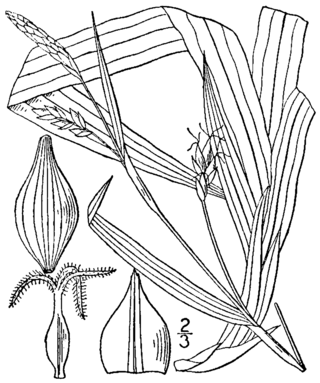
Carex careyana, commonly known as Carey's sedge, is a species of sedge found in the eastern United States and Ontario, Canada.
Carex arctogena is a member of the sedge family (Cyperaceae) which grows in high alpine areas. It is one of the few "bipolar" species; it has populations in Greenland, Scandinavia, Russia, Canada and southern South America. Plants in the far north and south appear to be genetically identical, having taken advantage of a similar niches on opposite ends of the globe.

Carex baileyi is a sedge in section Vesicariae the genus Carex native to the Appalachian mountains in Eastern North America. It is commonly called Bailey's sedge. Carex baileyi was named in honor of Liberty Hyde Bailey by its discoverer, Nathaniel_Lord_Britton.
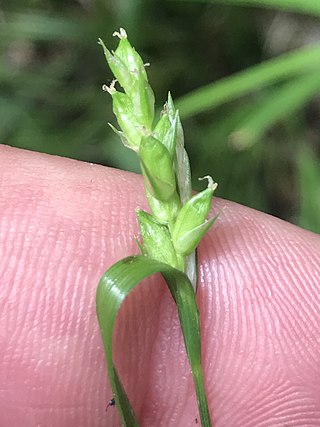
Carex amphibola, known as gray sedge, is a species of flowering plant in the family Cyperaceae. It was first formally named in 1855. Carex amphibola is native to the eastern United States and Canada.

Carex stipata, variously called the prickly sedge, awl-fruited sedge, awlfruit sedge, owlfruit sedge, swamp sedge, sawbeak sedge, stalk-grain sedge and common fox sedge, is a species of flowering plant in the genus Carex, native to Canada, the United States, China, Korea, Japan, and Far Eastern Russia. It is a wetland obligate.

Carex muehlenbergii is a species of flowering plant, it is a type of sedge. It is a grass-like plant in the family Cyperaceae. Its common names include sand sedge, Muhlenberg's sedge.
Carex deweyanaDewey's sedge, short-scale sedge, is a species of sedge native to Canada and the United States.

















